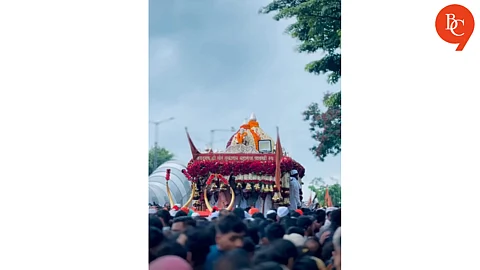

This is the story of a day spent with the Sant Tukaram Maharaj Palkhi procession, a journey not just measured in kilometers, but in devotion per step.
The Chariot of Devotion
The Palkhi, adorned with marigolds, saffron flags, and traditional horns, carries the sacred padukas (footwear) of Sant Tukaram Maharaj. It is not merely a chariot—it’s a living symbol of Maharashtra’s soul. The nameplate reads: “Aashadhi Shri Sant Tukaram Maharaj Palkhi Sohla”—an annual spiritual tradition marching across centuries.
As it rolled past the wide roads of Akurdi, the air turned electric with bhajans, cymbals, and the scent of wet earth.
The Crowd, the Color, the Collective Spirit
The roads were flooded—not with rain, but with people. Men, women, children, all dressed in white, saffron, or sometimes just in simplicity. Their eyes sparkled with a sense of purpose. Some danced. Some sang. Others walked silently, palms pressed together.
It wasn’t chaos. It was choreography—one born out of emotion and belief.
Under the Shade of Faith
As the Palkhi moved closer to Nigdi, the roads lined with curious onlookers, volunteers distributing bananas and water, and locals with folded hands standing respectfully under trees.
This was not a passive crowd. It was an embracing one—offering rest, respect, and refreshment.
More Than a Procession, a Moving Pilgrimage
From Akurdi to Nigdi, the 7-km stretch became a sacred corridor—where urban life paused to let spirituality pass. The honks were replaced by mridangam beats, the rush replaced by rhythm. And for a while, the city felt like a village again—grounded, reverent, alive.
The Palkhi isn’t just about reaching Pandharpur. It’s about what you carry within you as you walk. This stretch from Akurdi to Nigdi may be small on the map, but on foot, with faith—it feels infinite.
And somewhere in that walk, you find what many seek at the end of long journeys: peace, presence, and purpose.
